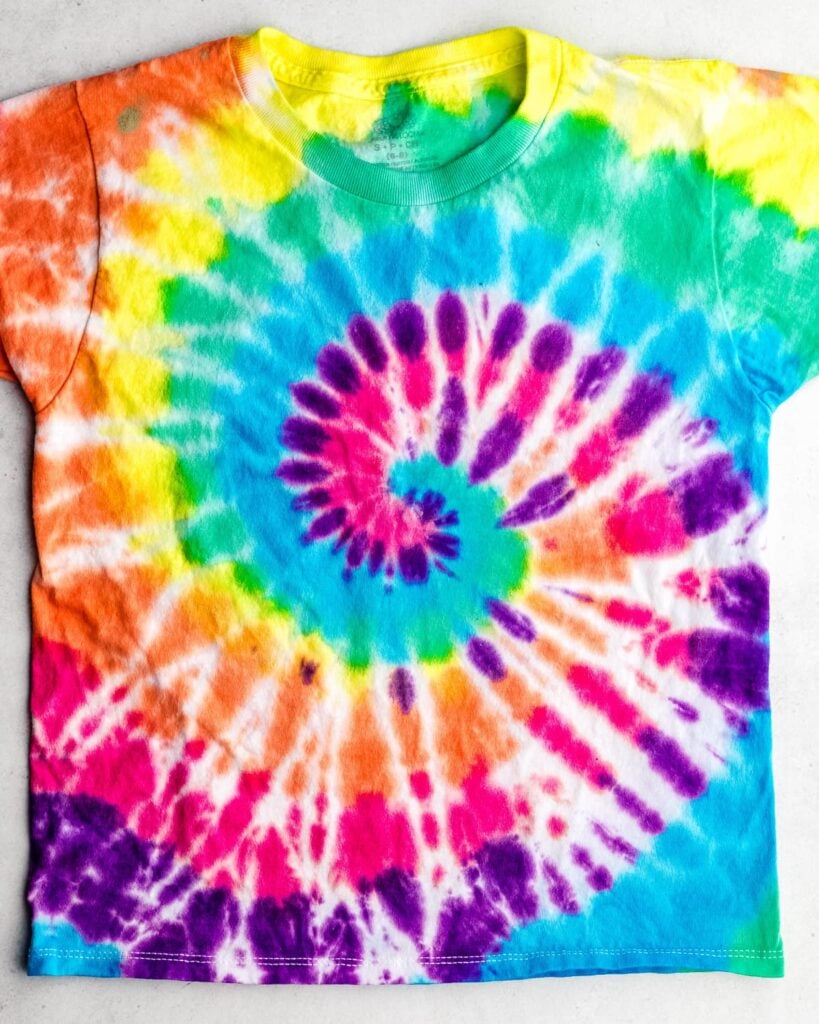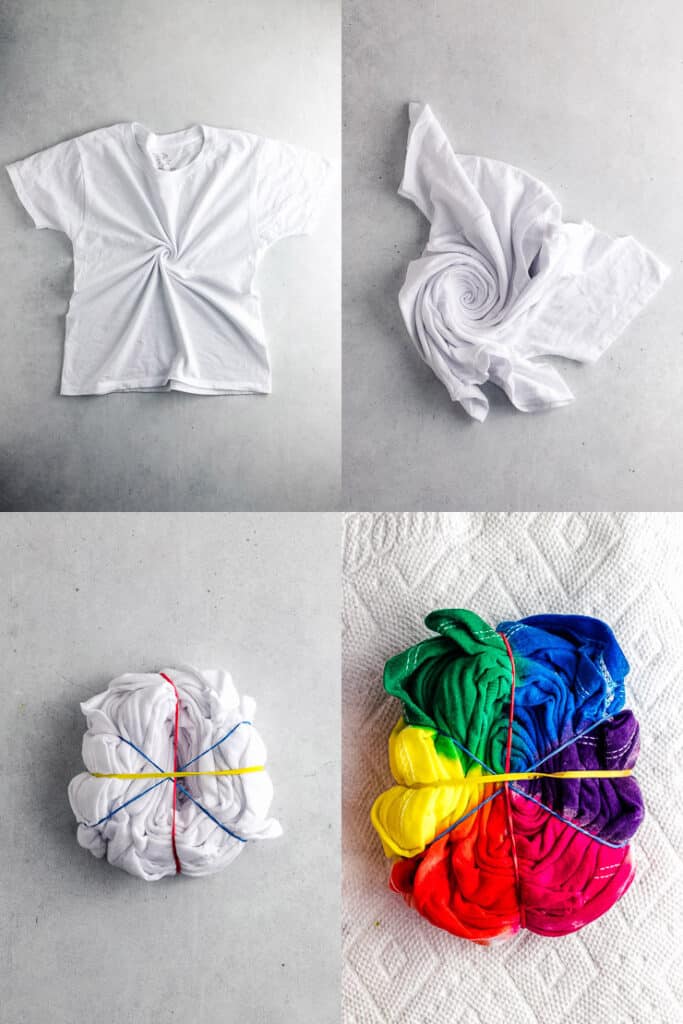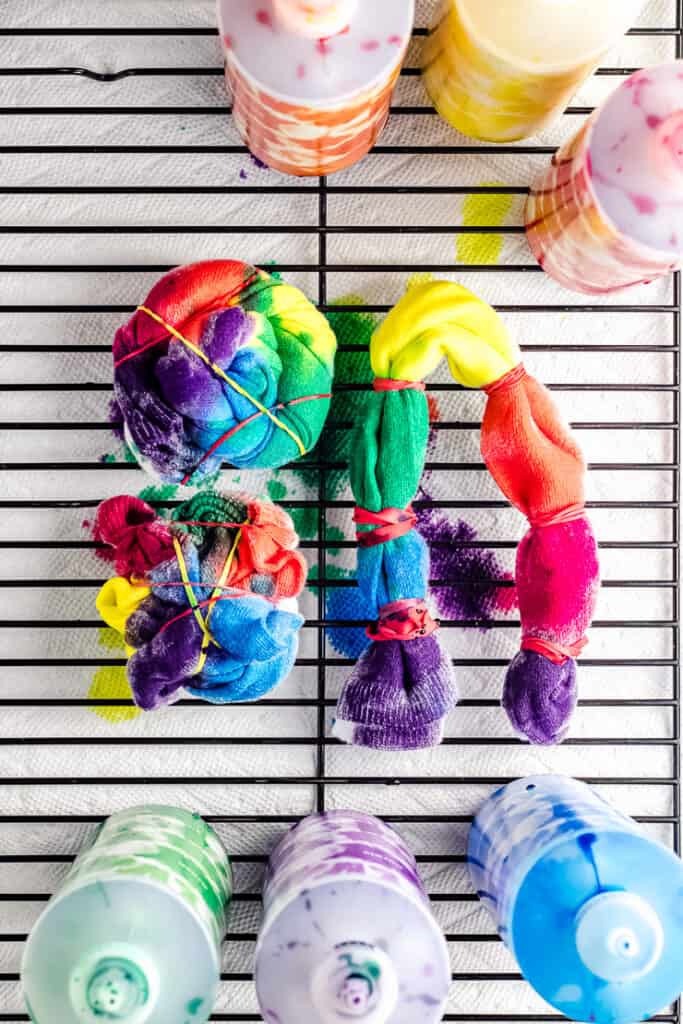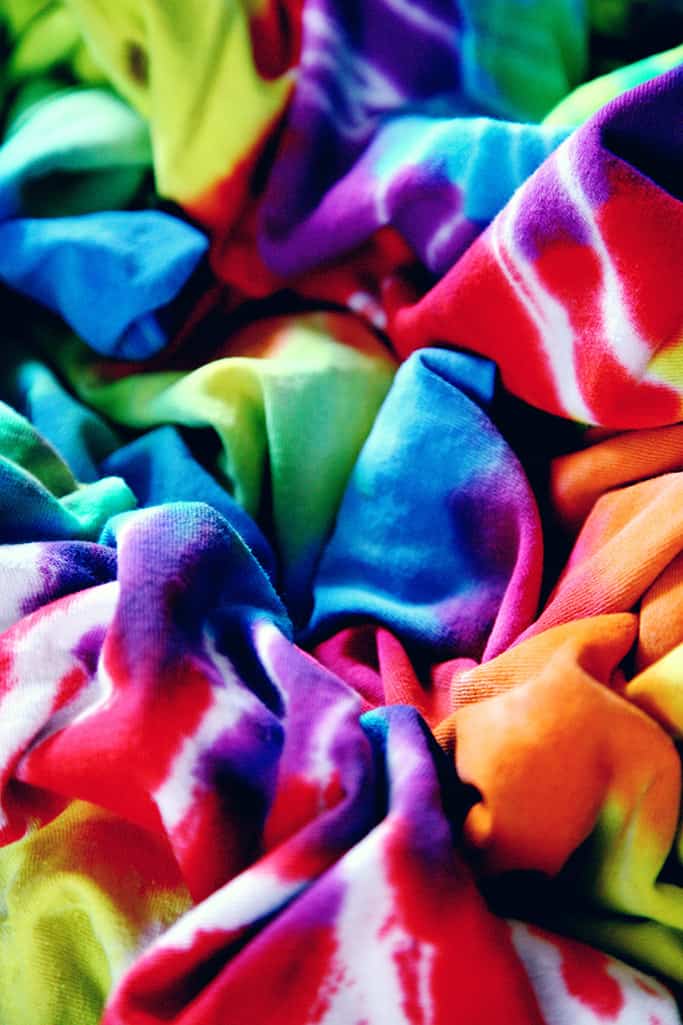Tie-dye is a fun way to express your creativity and have some fun. And if you’re like most people, you want your tie-dye t-shirts to stay bright and vibrant for years to come. In this blog post, I’ll teach you how to set tie-dye the right way so that it doesn’t fade in the wash. I’ll also share some helpful tips and tricks that I’ve learned over the years so that you get the best results.

Summertime is the perfect time to learn how to tie-dye and have some fun! And after spending all that time perfecting your tie-dye folding patterns, you’ll want your tie-dye shirts to stay bright, bold, and beautiful.
How to Keep Tie Dye From Fading
The key to getting vibrant colors is setting the dye properly. If you don’t set the dye correctly, your colors will fade over time, and your shirt will look old and tired.
So, how do you set tie-dye?
Spoiler alert: vinegar is not the answer! Some people recommend setting tie-dye with white vinegar or salt to keep colors bright, but that’s just not necessary.
To help you get the best results, I’ve put together a few tips on how to make sure your tie-dye looks great wash after wash.
- Choose the right fabric dye
- Choose the right fabric
- Follow the proper procedure
- Let the tie-dye set long enough
- Rinse and wash the dyed items correctly
Read on to learn the best ways to set tie-dye and keep your shirts looking vibrant for years to come!
Choose the Right Type of Dye
The most important thing you can do to make sure your tie-dye doesn’t fade is to select high-quality dyes that won’t wash out and fade over time.
The best type of tie-dye to use on cotton fabric is fiber reactive dye. Fiber-reactive dyes react with cotton and other plant fibers to form a permanent chemical bond.
If you use them correctly, fiber-reactive dyes are permanent – they won’t fade, even after repeated washings. In general, if you are using quality fiber reactive dyes for your projects, they will remain bright and beautiful, and you shouldn’t have a problem with fading.
Best Types of Fiber Reactive Dyes
Here are the types of fiber-reactive dyes that I recommend.
Procion MX dyes. This is the most popular type of dye for tie-dye enthusiasts and professionals. Procion MX dyes are colorfast, non-toxic, and very easy to use. Plus, they come in a huge range of colors. You can find Procion dye kits from suppliers like Jacquard or Dharma Trading Co.
Note: When you’re working with Procion MX dyes, you’ll need to pre-soak your fabric in a soda ash solution before dying.
Tulip One-Step dyes. These tie-dye kits are super easy to use, so they’re an excellent choice for the occasional tie-dyer, younger kids, and tie-dye parties. The Tulip dyes are formulated with soda ash already in the dye powder, so all you have to do is add water, shake and apply. This eliminates the need to pre-soak fabrics in a soda ash solution.
Don’t use all-purpose dyes.
If you want bright, vibrant cotton shirts that won’t fade in the wash, you should always use fiber-reactive dyes rather than all-purpose dyes.
All-purpose dyes, such as Rit and other brands, do not work on cotton or other cellulose fibers at room temperature.
The cold-water, squirt-bottle tie-dye technique only works with fiber-reactive dyes. If you try it with all-purpose dyes, the colors will pale and wash out over time.
Choose the Right Fabric
The second most important step to getting bright tie-dye that won’t fade is using the right fabric.
For example, the best type of fabric to use with fiber-reactive dye is 100% cotton or other cellulose fiber like rayon, linen, Tencel, or hemp. If you can’t find 100% cotton, look for at least a 70% cotton blend.
You can try using a 50% cotton 50% polyester blend, but the colors will be much paler. (It will give you a nice pastel tie-dye look, though, if that’s what you’re going for!)
Synthetic fibers like polyester require a different type of dye altogether. If you try to tie-dye 100% synthetic fiber with fiber-reactive dyes, you won’t get good results.
Related Reading: If you want to tie-dye polyester or other synthetics, you’ll need to use a special type of dye and a high-heat technique.

Follow the Tie Dye Process
Here’s a quick guide to tie-dying a t-shirt so that the colors stay bright and don’t fade. For complete instructions, read this step-by-step guide to tie-dye. And after that, you’ll want to check out this list of 17 ways to fold tie-dye.
Instructions
Here is how to tie-dye cotton fabric with fiber-reactive dyes (and optional soda ash pre-wash):
- Prewash your fabric.
- Wearing eye protection and a mask, prepare a soda ash solution of 1 cup soda ash in one gallon of warm water. Pre-soak your fabric in a soda ash solution for at least 15 minutes.
- Wearing rubber gloves, wring out the fabric until it’s just damp. Tie or bind the material as desired.
- Prepare the dye as instructed on the package. Apply the dye as desired.
- Place the dyed fabric in a plastic bag, or wrap it in plastic wrap to keep it from drying out. Let the fabric set in a warm room for at least 8 hours or overnight.
- Remove the fabric from the plastic, and remove the rubber bands or ties. Rinse the fabric in cold water several times until the water runs clear.
- Wash the dyed fabric in hot water in your washing machine with Synthrapol or another laundry detergent, and hang dry.
Remember: You only need to use the soda-ash presoak if you’re using the Procion MX dyes. If you’re using the Tulip kits, you don’t need to do the presoak.
Let’s talk about a few of these steps in a little more detail – particularly how to set the tie-dye to prevent the dye from fading.
How to Set Tie Dye
Once you have finished applying the dye, you need to let it set, or “process.” The dye needs three things to react with the fabric and create a permanent chemical bond: time, water, and heat.
How long does tie-dye need to sit?
Let the dye set on the fabric for a few hours – at least 8 hours, but preferably overnight. Longer setting times will result in brighter, stronger colors. The amount of time required will depend on the ambient temperature.
How to speed up the setting process?
Let the tie-dye fabric set at temperatures over 70°F (21°C) for the best results. The dye reaction takes longer at cooler temperatures. So if your room is too cold and you don’t wait long enough, you may get pale, faded colors.
How to keep the dye from drying out?
For the reaction to take place, the fabric must stay wet. To keep the fabric from drying out, you can place it in a zip-top plastic bag or wrap it in plastic wrap. (I always put my wrapped shirts in a bucket, just in case they drip or leak.)

Some Color Rinsing Out is Normal
Even if you’re using high-quality dyes, you might see some dye rinsing out of your tie-dyed fabrics for the first couple washes. This is normal. Most dyes need at least one long rinse in cool water (without detergent) followed by two washes in hot water (with detergent) to remove excess dye. This is just the extra dye leaving the fabric.
The Right Way to Wash Tie Dye
After you rinse the tie-dyed garment in cool water, you can run it through a wash cycle in your washing machine. It’s a good idea to use a special detergent, called Synthrapol, to wash out excess dye and prevent the dye colors from mixing. (Synthrapol doesn’t help set the dye – it just helps wash out the extra dye.)
You may need to wash the tie-dyed garments separately for the first few washes. But after that, you’ll be safe to wash them with your regular laundry.
Using Commercial Dye Fixative
In most cases, following the instructions above should be enough to set the tie-dye, keep it colorfast, and prevent it from fading in the wash.
That said, some commercial dye fixatives can be used to set tie-dye. Retayne is a commonly used dye fixative that will prevent color bleeding during washing. You can find Retayne in stores like Dharma Trading Company. Make sure to follow the instructions on the package.

Other Tricks to Set Tie Dye
You may have seen some other ideas about setting tie-dye with vinegar, baking soda, or salt. Let’s talk about them.
Does vinegar help set tie-dye?
No, vinegar will not help to set fiber-reactive dye on cotton fabric. Nor will not make the dye more resistant to fading.
Contrary to popular belief, you do not need vinegar to set tie-dye on cotton. Unless your tie-dye kit specifically tells you to use vinegar, you don’t need it.
Note: Vinegar can help set some acid dyes on animal fibers like silk or wool – but it’s not necessary to set dye on cotton fabrics.
Does salt help set tie-dye?
No, washing tie-dyed items with table salt will not help the dye set better. Salt is not a dye fixative and won’t make the dye more permanent or colorfast.
What about baking soda?
Baking soda is sometimes recommended as a substitute for soda ash; however, its effects are much weaker.
What will actually help set the tie-dye?
The best way to set tie-dye is to let it process in a warm, moist environment for 8-24 hours.
The Best Way to Keep Tie Dye From Fading
So, what do you need to prevent dye from fading? Let’s sum up.
- First, make sure to use the right type of tie-dye for your fabric. To do the cold-water, squirt-bottle style tie-dye, you’ll want to use fiber-reactive dyes like Tulip or Procion MX dyes.
- Second, use the right kind of fabric. For the brightest, most vibrant results, use cotton fabric.
- Then, follow the right tie-dye process. Read the dye instructions to know if you need to pre-soak the fabric in a soda ash solution.
- Next, let the tie-dye set long enough! Keep your tied-dyed fabric wet and warm for at least 8 hours – or up to 24 hours – for the strongest colors.
- Finally, rinse and wash the dyed items correctly. Some dye rinsing out is expected – but if you follow the steps, you should still get a colorfast result.
More Tie Dye Tutorials
For even more information about tie-dye, check out the following articles:
- How to Tie Dye – Easy Techniques for Beginners
- 17+ Tie Dye Patterns and Folding Techniques
- How to Ice Dye – Easy Tie Dying Tutorial
- How to Tie Dye with Bleach – 5 Folding Techniques
What’s Next?
Pin this post: Save this tutorial to your Pinterest boards so that you can come back to it later.
Leave a comment: We love to hear your feedback. Tell me in the comments below!
Share on Instagram or Facebook: When you make this project, share it on social media and tag me @sarahmaker_. We love to see what you make!
Have questions? Join the Facebook Group!
We hope this article was useful for you! If you have any additional questions, feel free to join my Facebook Group. We created this group for you to share pictures, ask questions, and help each other out.









Similar Posts
How Long to Let Tie Dye Sit Before Rinsing It Out
How to Tie Dye a Spiral Pattern: A Step-by-Step Guide
How to Use Soda Ash for Tie-Dye
How to Rinse & Wash Tie-Dye the First Time
17+ Tie Dye Patterns and Folding Techniques
How to Bleach Tie-Dye a Sweatshirt – Easy DIY